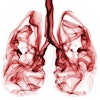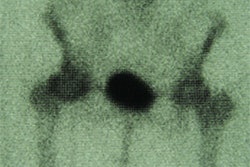VIENNA - A group of researchers from Calmette Hospital at the University of Lille in Lille, France have successfully imaged pulmonary arteries down to the 6th order using multidetector CT (MDCT).
Dr. Benoit Ghaye presented the subsegmental imaging findings of he and his colleagues from Lille at the European Congress of Radiology. The aim of the group’s study was twofold: to determine the frequency and order of well-visualized peripheral pulmonary arteries with MDCT, and to compare the results with those obtained with thin collimation single-detector CT (SDCT).
The researchers based their study on the evaluation of the peripheral pulmonary arteries of 30 consecutive patients devoid of pleuroparenchymal disease. These patients were then scanned with contrast-enhanced MDCT at a collimation of 4 ×1 mm, a pitch of 1.7 to 2, and a scan time of 0.5 seconds.
The authors selected two series of scans from each MDCT data set and then systematically reconstructed them. They broke the 30 patients into two groups and reconstructed the scans for Group 1 at 1.25 mm slices, and 3 mm slices for Group 2.The resulting data set for analysis consisted of 600 segmental, 1,200 subsegmental, 2,400 5th order, and 4,800 6th order pulmonary arteries in each group.
Each artery was coded as analyzable by the researchers when the vessel was depicted without partial volume effect from its proximal to its distal portion. The MDCT results were then compared with those obtained in a matched population of 20 patients (Group 3) scanned with SDCT at a collimation of 2 mm, a pitch of 2, and a scan time of 0.75 seconds.
The images were then consensus-interpreted on film by two radiologists blinded to the results. The MDCT scans with the 1.25-mm thick reconstructed sections allowed analysis of 94% of the subsegmental arteries, compared with 62% of the 3-mm slices. Against the SDCT images, the MDCT Group 1 images were also perceived as significantly better images, 94% vs. 84%, respectively.
In addition, the results showed a significantly higher depiction of 5th and 6th order arteries compared with Group 2. The 5th and 6th order arteries were identified in 74% and 35% of the cases of Group 1, and in 47% and 16% of the cases of Group 2. Benoit said that the reasons given for inadequate depiction of 5th and 6th order arteries of Group 1 were partial volume effect, anatomic variants, cardiac motion artifacts, and a single respiratory motion artifact.
Although MDCT with 1.25-mm thick reconstructed scans showed that evaluation of peripheral pulmonary arteries down to the 6th order could be obtained, there was one drawback. Benoit noted that the ability to scan the entire thorax with narrow collimation could be expected to modify a radiologist’s ability to read the entire volume of images.
By Jonathan S. Batchelor
AuntMinnie.com staff writer
March 4, 2001
Click here to post your comments about this story. Please include the headline of the article in your message.
Copyright © 2001 AuntMinnie.com



















